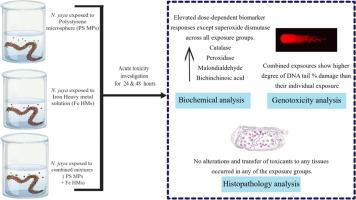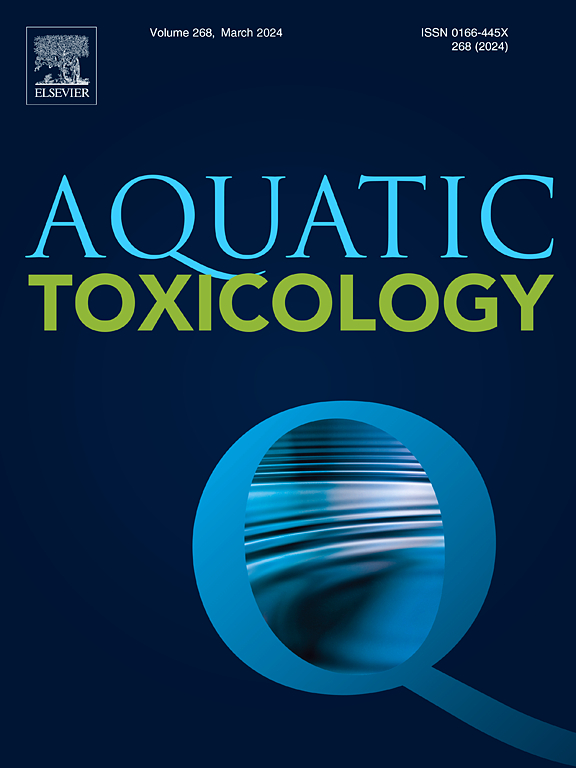评估铁(Fe)和微塑料的综合急性毒性对鲎的影响。
IF 4.3
2区 环境科学与生态学
Q1 MARINE & FRESHWATER BIOLOGY
引用次数: 0
摘要
海洋生态系统中的重金属(HMs)和微塑料(MPs)污染问题日益受到关注,这主要是人为活动造成的,对生态健康构成了重大威胁。了解重金属和微塑料的综合暴露有助于进行毒性评估。在这项研究中,我们考察了聚苯乙烯微塑料(MPs)和铁(Fe)对Namalycastis jaya的氧化应激、生物累积、组织病理学和遗传毒性的综合影响。氧化应激是通过分析超氧化物歧化酶(SOD)、过氧化氢酶(CAT)、过氧化物酶(POD)、丙二醛(MDA)和双链霉素(BCA)的水平来评估的,而遗传毒性则是通过彗星试验来评估的。通过电感耦合等离子体-光发射光谱分析法(ICP-OES)进行的生物累积分析表明,在联合接触中观察到的最高值(4.790 微克/毫升)强调了 MPs 对多毛目环节动物体内铁(Fe)累积的显著增加。生化分析表明,在接触单种污染物 48 小时内,多毛目环节动物体内的氧化损伤变得明显。基因毒性检测进一步表明,与单独暴露相比,联合暴露中的 DNA 损伤程度更高。同样,组织病理学显示,在联合接触中,肠道上皮细胞发生了轻微的改变。很明显,MPs 会加剧多毛目动物体内由铁引起的氧化和 DNA 损伤。这项研究为铁和多溴联苯的环境安全风险评估提供了有价值的信息,有助于我们了解海洋生态系统中这些污染物之间复杂的相互作用。本文章由计算机程序翻译,如有差异,请以英文原文为准。

Evaluating the impact of the combined acute toxicity of iron (Fe) and microplastics on Namalycastis jaya
The rising concern over heavy metals (HMs) and microplastics (MPs) pollution in marine ecosystems, primarily driven by anthropogenic activities, poses significant threats to ecological health. Understanding the combined exposure of HMs and MPs aids in toxicity assessment. In this study, we examined the combined effects of polystyrene microplastics (MPs) and iron (Fe) on oxidative stress, bioaccumulation, histopathology, and genotoxicity in Namalycastis jaya. Oxidative stress was assessed by analyzing the levels of Superoxide dismutase (SOD), Catalase (CAT), Peroxidase (POD), Malondialdehyde (MDA), and Bicinchoninic acid (BCA), while genotoxicity was evaluated using the comet assay. Bioaccumulation analysis, conducted via Inductively coupled plasma-optical emission spectrometry (ICP-OES), indicated that the highest values (4.790 µg/ml) were observed in combined exposure, emphasizing the significant increase in iron (Fe) accumulation in polychaetes facilitated by MPs. Biochemical analysis revealed that oxidative damage in polychaetes became evident within 48 h of exposure to individual contaminants. However, in the case of combined exposures, elevated stress levels were observed within just 24 h. The genotoxic assay further demonstrated a higher degree of DNA damage in the combined exposure compared to individual exposures. Similarly, histopathology revealed mild alterations in the gut epithelium in combined exposures. It is evident that MPs intensify both oxidative and DNA damage induced by Fe in polychaetes. The insights gained from this study provide valuable information for the risk assessment of Fe and MPs in environmental safety, contributing to our understanding of the complex interactions between these pollutants in marine ecosystems.
求助全文
通过发布文献求助,成功后即可免费获取论文全文。
去求助
来源期刊

Aquatic Toxicology
环境科学-毒理学
CiteScore
7.10
自引率
4.40%
发文量
250
审稿时长
56 days
期刊介绍:
Aquatic Toxicology publishes significant contributions that increase the understanding of the impact of harmful substances (including natural and synthetic chemicals) on aquatic organisms and ecosystems.
Aquatic Toxicology considers both laboratory and field studies with a focus on marine/ freshwater environments. We strive to attract high quality original scientific papers, critical reviews and expert opinion papers in the following areas: Effects of harmful substances on molecular, cellular, sub-organismal, organismal, population, community, and ecosystem level; Toxic Mechanisms; Genetic disturbances, transgenerational effects, behavioral and adaptive responses; Impacts of harmful substances on structure, function of and services provided by aquatic ecosystems; Mixture toxicity assessment; Statistical approaches to predict exposure to and hazards of contaminants
The journal also considers manuscripts in other areas, such as the development of innovative concepts, approaches, and methodologies, which promote the wider application of toxicological datasets to the protection of aquatic environments and inform ecological risk assessments and decision making by relevant authorities.
 求助内容:
求助内容: 应助结果提醒方式:
应助结果提醒方式:


